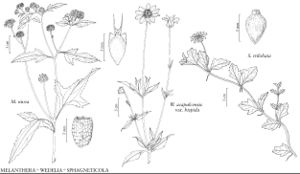Sphagneticola
Notizbl. Königl. Bot. Gart. Berlin 3: 36. 1900.
| Taxon | Illustrator ⠉ | |
|---|---|---|
 | Melanthera nivea Wedelia acapulcensis var. hispida Sphagneticola trilobata | Yevonn Wilson-Ramsey Yevonn Wilson-Ramsey Bee F. Gunn |
Perennials, mostly 30–200 cm. Stems prostrate, branched ± throughout (rooting at nodes, usually ± succulent). Leaves cauline; opposite; sessile or petiolate; blades (usually 3-nerved) mostly trullate to lanceolate, often obscurely 3-lobed, bases ± cuneate, margins entire or toothed, faces usually scabrous. Heads radiate, borne singly. Involucres obconic, 6–12 mm diam. Phyllaries persistent, 12–15 in 2–3 series (outer larger, more foliaceous than inner). Receptacles convex to conic, paleate (paleae conduplicate, scarious, acute). Ray-florets 4–10+, pistillate, fertile; corollas yellow to orange. Disc-florets 30–60+, bisexual, fertile; corollas yellow to orange, tubes shorter than campanulate throats, lobes 5, lance-triangular. Cypselae strongly biconvex to plumply 3–4-angled (epidermes usually thick, corky, smooth or tuberculate, apices rostrate, each bearing central neck or boss, rostra obscure in mature fruits); pappi 0, or persistent, coroniform (erose or fimbrillate to lacerate, 0.1–0.6 mm). x = 15.
Distribution
Introduced; Mexico, West Indies, Bermuda, Central America, South America, Asia, Indian Ocean Islands, Pacific Islands, Australia
Discussion
Species 4 (1 in the flora).
Selected References
None.
Lower Taxa
"broader" is not a number.